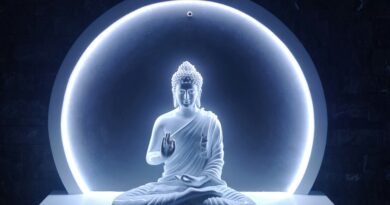
Inside and Outside: The Quantum Dance of Perception and Reality
We seem to think there is an outside and there is an inside, but interestingly, we do not realize that we are determining the outside by altering the inside. For example, when one touches a table, one infers it is solid based on the reaction of the associated neurons within our body. So the activity within our body determines what is outside. Does this mean that if we change the activity inside, we can change the outside?
This idea invites us to consider a deeper truth, one that has been explored by both modern physics and ancient wisdom traditions, such as Buddhism. In Buddhism, the concept of “dependent origination” tells us that everything we experience is interdependent. There is no “outside” world that is fixed and separate from us. Instead, the world arises through our perceptions, actions, and mental formations. Our internal states—the thoughts, emotions, and energies we cultivate—are reflected in how we interact with the world around us. The internal and external are not distinct entities, but rather expressions of a single, interconnected reality.
If we shift our internal state, can we change the way we perceive and, ultimately, engage with the world? The answer, according to Buddhist teachings, is yes. Through mindfulness and meditation, we cultivate awareness and clarity, allowing us to transform our internal responses. In doing so, we begin to perceive the world not as a fixed and immutable object, but as a fluid, ever-changing interplay of phenomena, shaped by our own consciousness.
To illustrate this, we can look at the famous double-slit experiment in quantum physics, which powerfully underscores the role of observation and the observer’s mind in shaping reality. In this experiment, particles (like photons or electrons) are fired at a screen with two slits. When not observed, these particles behave like waves, passing through both slits simultaneously and creating an interference pattern on the screen. However, when the particles are observed, they behave like particles, passing through only one slit, and no interference pattern is formed.
This dramatic shift in behavior based on observation suggests that the “external” world is not as fixed and independent as we once believed. The act of measurement—or even the potential for measurement—seems to shape the outcome. In a sense, the external world doesn’t just exist independently of our consciousness; it is inextricably tied to it. Just as the mind shapes our perception of the world, the observer’s role influences the behavior of quantum particles. This is not to say the world is “created” by the mind, but rather that the mind and the world are co-arising, in constant relationship, shaping each other in ways we are only beginning to understand.
This leads us to ask: if we can change the internal, can we change the external? The answer, according to Buddhist teachings, is yes. Through mindfulness and meditation, we cultivate awareness and clarity, allowing us to transform our internal responses. In doing so, we begin to perceive the world not as a fixed and immutable object, but as a fluid, ever-changing interplay of phenomena, shaped by our own consciousness.
This notion resonates deeply with Einstein’s quote: “Physical concepts are free creations of the human mind, and are not, however it may seem, uniquely determined by the external world.” Our perception of physical reality is shaped by the mind, and if we change the mind, we can change our experience of reality. The double-slit experiment exemplifies this: what we “see” in the world depends on how we interact with it, how we observe it, and what we bring to it—an insight that blurs the line between the internal and the external.
In the end, the boundaries between “inside” and “outside” are more fluid than we tend to believe. The external world is not a static backdrop against which our lives unfold. It is a dynamic interplay with the mind, constantly influenced by our perceptions, thoughts, and actions. And perhaps, in learning to transform our inner landscapes, we can begin to see the world more clearly, more compassionately, and more freely.
As the Buddha said, “We are what we think. All that we are arises with our thoughts. With our thoughts, we make the world.”
By incorporating the double-slit experiment, we highlight how the mind (or consciousness) plays a pivotal role in shaping not only our perception of the world but potentially the behavior of matter itself. This blend of science and Buddhist philosophy underscores the interconnectedness of all things and invites us to reconsider the boundaries between inside and outside, mind and world.
Image by Federico Beccari downloaded from unsplash.com



